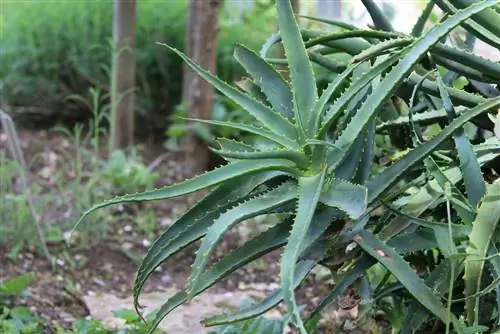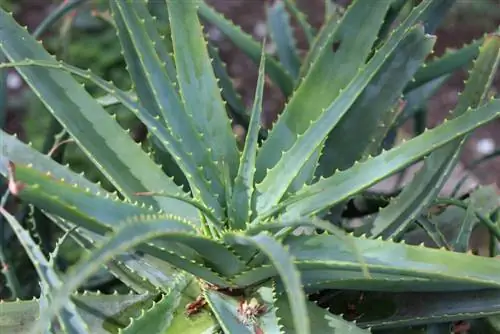- Author admin [email protected].
- Public 2023-12-17 03:39.
- Last modified 2025-01-24 12:45.
The Cape Aloe impresses with lanceolate, sword-shaped leaves, elegantly curved and up to 80 centimeters long. In early spring, a majestic, orange blossom rises above it to underline the exotic impression. The succulent, reinforced foliage and the breathtaking flowers are enthroned on a 3-5 meter high trunk. This spacious habitus requires a large garden and spacious winter garden to create a tropical flair. The following guide explains how to skillfully plant and care for an Aloe ferox.
Plants
In order to properly plant a Cape aloe that you have purchased or grown yourself, the quality of the pot comes into focus. Given the rapid growth, the pot should have a sufficient volume of at least 20 liters initially. If well cared for, even larger planters will be required. The decisive factor for their usability is not only the size, but also an opening in the floor as a water drain. A suitable substrate is an airy, loose cactus soil or a mix of 2 parts standard soil, 1 part sand and 1 part perlite. How to handle planting correctly:
- Create a 5-10 centimeter high drainage above the floor opening made of grit, pottery shards or expanded clay
- A spread out fleece prevents crumbs from the potting soil from clogging the drainage
- Fill in the recommended substrate up to half the height
- Place the potted Aloe ferox in the middle
- Surround with potting soil as high as before in the cultivation pot
- Press the substrate with your fist so that no cavities form and pour on
Given a minimum temperature of 8-10 degrees Celsius, planting in the bed does not make sense. The South African Cape aloe will only survive the local winter unscathed in exceptional cases. In order to give the appearance of a bed planting, creative hobby gardeners simply put the plant in the ground together with a bucket in May, only to take it out again in the fall to move to its winter quarters.
Tip:
Since the adult Aloe ferox has a considerable weight, knowledgeable hobby gardeners place the pot on a plant roller for unrestricted mobility.
Care

The successful care of a fire aloe rests on three pillars: location, water supply and nutrient balance. If these three factors meet the demands of the grass tree plant, it will forgive one or two omissions with good-natured tolerance. Beginners among hobby gardeners are therefore happy to take on the cultivation of a Cape aloe.
Location
In its South African homeland, the Aloe ferox thrives in the sun-drenched, sandy, lean Capeland. From this we can conclude that the ideal location conditions are:
- Sunny to full sun location
- Warm temperatures around 20 degrees Celsius and higher
- Ideally protected from rain
- Normal to warm and humid humidity
In indoor culture or in the winter garden, the tropical beauty wants to be placed as close to the window as possible. If the sun only hits the magnificent crown on one side, either additional lighting will compensate or you can rotate the Cape Aloe by a quarter every 3 days. Otherwise, the long leaves will search for more light, which creates an uneven habit. Thanks to its flexibility when it comes to humidity, the tropical tree feels just as comfortable in a heated living room as it does in the warm, humid ambience of the bathroom or indoor swimming pool.
Pouring
Regardless of its ability to store water in its long leaves, fire aloe requires a balanced water supply. If, in exceptional circumstances, there is a longer dry period, for example during vacation, the tropical tree can easily bridge this phase thanks to its succulent foliage. How to water an aloe properly:
- Water moderately when the substrate surface has dried to a depth of 2-3 centimeters
- Use lime-free rainwater or stale tap water
- Pour out a coaster after 5 minutes at the latest
The Cape Aloe should not be confronted with a completely water-soaked substrate or even waterlogging. When in doubt, prudent hobby gardeners water too little rather than too much.
Tip:
Pampering an Aloe-ferox every now and then with lime-free water from the spray bottle promotes the dull green, reddish foliage color and vitality.
Fertilize

Although the Aloe ferox develops a huge biomass as it grows, it is modest in terms of nutrient requirements. How to handle the care factor correctly:
- Pamper yourself with cactus fertilizer every 4 weeks from March to October
- Do not apply the preparation to dried soil
- Water with clear water beforehand
The magnificent leaves of the succulent appear even more beautiful if they are rubbed on the top and bottom with algae juice from time to time. At the same time, the leaf pores absorb valuable nutrients. To protect yourself from the strong spines along the edges of the leaves, it is recommended to wear thick work gloves and glasses. By the way, this precautionary measure is advisable for all planting and care work.
Cutting
The Cape aloe does not receive any pruning. If possible, withered leaves should remain on the trunk until they fall off on their own. During this time, the plant assimilates the remaining nutrients from the dying foliage. If this appearance bothers you, simply remove the sheet.
The inflorescence, which is up to 100 centimeters long, is cleaned out after wilting. Be particularly careful here as you have to reach into the rosette-shaped crown and come dangerously close to the sharp thorns.
Wintering
Year-round cultivation in the room or winter garden is possible without any problems. Winter rest from November to February nevertheless has a beneficial effect on the vitality of an Aloe ferox. If it is allowed to rest in a bright location at 10 to 12 degrees Celsius for a few weeks, this caution will benefit growth and the abundance of flowers. As wintering progresses, the amount of irrigation water is reduced. Fertilization will only be carried out again from the beginning of March.
If the exotic ornamental plant moves to the terrace or balcony in May, it spends the first week in partial shade. Only when the leaves have got used to the direct sunshine will the plant tissue not burn.
Repotting
If the previous planter no longer offers enough space for the roots, the fire aloe is repotted. A good time for this care measure is early spring, shortly after the end of the winter break.
If you bought a young plant in the garden center, it is often found in unsuitable substrate, such as conventional potting soil. On the one hand, this is too rich in nutrients and, on the other hand, tends to compact, which is not beneficial for root growth. In this case, it is advantageous to immediately repot into one of the recommended substrate mixtures.
Propagate

A well-established Cape aloe produces side shoots in the root area. These children are ideal for easy propagation. Spring is the best time to start breeding. Here's how to do it:
- Cut off side sprouts that are 15-20 centimeters long
- Fill a pot each child halfway up with a mix of herbal soil and sand
- Plant the daughter plant as deep as before on the mother plant and water it
In a partially shaded location at 20 to 25 degrees Celsius, rooting will progress within the next few weeks. To speed up the process, put a plastic bag over them or put the children in a greenhouse. The substrate should be kept constantly moist without becoming waterlogged. The growing Aloe ferox does not yet receive any fertilizer. As an incentive for root growth, resourceful hobby gardeners add a layer of mature compost under the growing substrate. Successful propagation is signaled by fresh shoots. The transparent hood then falls away. Once your pupil has completely rooted his pot, it is repotted into normal succulent soil so that it can be cared for as a full-fledged plant.
Conclusion
Reducing Cape aloe solely to its medicinal ingredients in the succulent leaves does not do this exotic tree plant justice. The evergreen fire aloe has an impressive crown over which bright orange flowers rise in early spring. The majestic stature with a height of 3 meters and more demands a sunny spot in the large garden, the spacious living room or winter garden. Planted in an exemplary manner in a large pot, in loose, permeable cactus soil, care is limited to a few aspects. Moderate watering and fertilizing every 4 weeks does not pose any particular challenges, even for beginner hobby gardeners. Only the leaves with hard thorns require special precautions.






